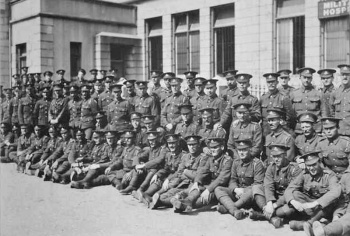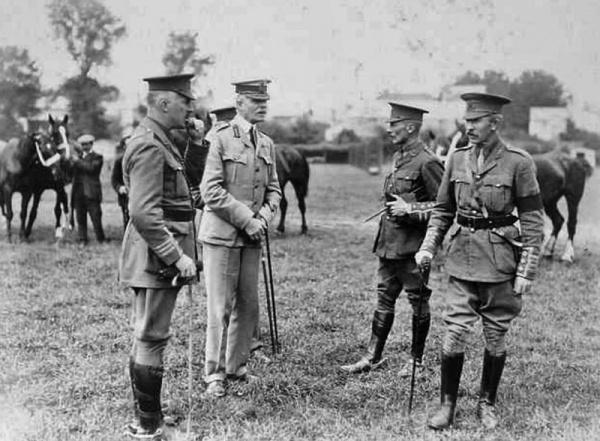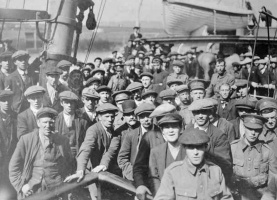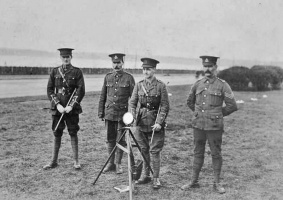Arrival in 1914
On 9 August 1914 the South Staffordshire Regiment’s 4th (Extra Reserve) Battalion landed at St Helier Harbour, led by their Commanding Officer, Lt-Colonel Edward Bulwer, and his Second in Command, Major Douglas Seckham.
In these early days of the War, divisions, units and the men were on the move. The barracks were being emptied of the resident infantry battalions as they moved to the divisional assembly areas and, from there, on to the ports of disembarkation for France. With depots unable to cope with the numbers, infantry reserve battalions (generally the 3rd and 4th battalions) were sent to occupy empty premises in thedays following mobilisation.
Both of the South Staffordshire Regiment’s reserve battalions had formed up at Lichfield on 4 August. The 3rd battalion went to Plymouth and the 4th to Jersey. Establishing themselves at Fort Regent and elsewhere, the battalion now required two things so that they could get down to the important business of training men for war. The first requirement was for the officers’ chargers, and thus they embarked upon buying horses. The second requirement was the men themselves.
These men were reservists and had probably retained their uniforms from the period of their colour service, and would have been advised to leave as much of their civilian clothes at home as possible when picking up their travel warrants. By late October 1914, the battalion was beginning to cut a dash as a military unit.
The number photographed on parade on the beach in St Aubin's Bay totalled a remarkable 1,918 all ranks, a figure that was almost double the establishment for a regular Battalion, and thus requiring more than the standard quantity of rifles, sets of equipment and uniforms to kit the men out. This number was probably two to three times the combined strength of the Devonshires and the Artillerymen who had left the Island shortly after mobilisation. So, more bed spaces would have needed and there were more mouths to be fed.
There was space at Fort Regent and St Peter’s Barracks and a number of the officers were billeted in the Grand Hotel at West Park. Bell tents were also erected at the barracks, and it is likely that vacated married quarters at Green Street and St Peter’s Barracks also housed men. Some photographs were taken at Elizabeth Castle, but it is not evident that it was used as accommodation.
Before the War the garrisons would have had contracts with civilian suppliers, arranged by the District Headquarters, and this would have continued with increased numbers. Suppliers would have welcomed this increase because civilian trade would have dropped with the mobilised French and British reservists leaving the Island.
Once settled in, the men would soon become very familiar with the Fort’s drill square and the intricacies of the Drill Manual.
As the war progressed, training had to be adapted to take on board new weaponry, such as hand grenades. It also proved dangerous as two young officers would discover at St Peter’s Barracks, one tragically. In February 1916, when a man dropped a grenade when he was loading it into a catapult thrower and then panicked, Lt Charles Bartlett quickly picked up the live grenade and threw it over the parapet, where it soon exploded. For this he was awarded the Albert Medal to add to a Military Cross received the year previously while serving with the Regiment’s 1st Battalion. The other officer, on the right, was 2nd Lt Gerald Dutton who died in very similar circumstances on 5 May, just under six months after receiving a probationary commission. He was buried with full military honours at St Peter’s Church, and because of that he is in theJersey Roll of Honour.
In 1916 other new weapons, such as the BSA produced 0.303 inch Lewis Gun, were becoming readily available. Waiting for their turn to have a go at the range near the barracks. Of the seven officers pictured, only the instructing officer, Second Lieutenant Edmund Sacheverell Wilmot, would die, on 13 November 1916. He is buried at Serre Road No 2 British Cemetery. He had come from Canada and had been a Sergeant in the Canadian Mounted Rifles. The culmination of the recruits’ basic training would probably take the form of a passing out parade, in which the men would parade in front of the inspecting officer. The photograph shows such a parade at Fort Regent. They are also accompanied by the Corps of Drums, and after being inspected, they would have marched around the square a few times, led by the Drums, and they were then ready to be sent to the 1st or 2nd Battalions.
A brief spot of leave would now follow, but not before the men had received a medical inspection, inoculations, railway warrants and travel instructions.
On the evening of 6 September 1916, the 4th Battalion said goodbye to Jersey, and headed off to Marske and then Redcar in Yorkshire. It subsequently evolved from being an Extra Reserve Battalion into an active service Battalion. After a period of training at Canterbury, between June and October 1917, it landed at Le Havre to join the 25th Division. In June, 1918 it was transferred to the 50th Division. Three weeks later it was reduced to a training cadre before joining the 39th Division at Etaples on 16 August 1918. On 6 November 1918 it was disbanded.

Below the barracks at Greve de Lecq, where some of the men were quartered
On the parade ground at Fort Regent
On the parade ground at Fort Regent






















